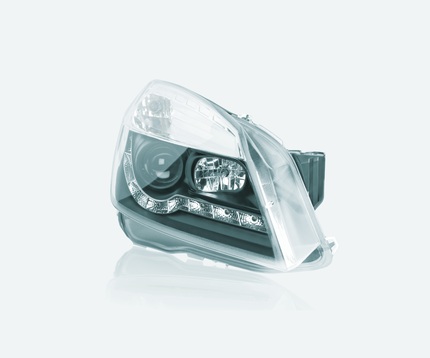
As automotive OEMS rethink refrigerants, they can rely on Linde's supply expertise to provide R744 - a more sustainable solution that meets the strictest specifications.
As the plastics industry bends back into shape, Linde's PLASTINUM® CO2 portfolio helps customers inject some serious productivity gains.

The global impact of COVID-19 has been unprecedented, exposing industries worldwide to multiple challenges. Many manufacturing activities globally were slowed down or even halted which had a significant impact on the demand for plastic products - especially from big buyers like the automotive, building and construction industries. As a result, the global plastics market saw a decline of 1.2% in 2020, Europe suffered a downwards slide of 5.1% at 55 million tonnes and the automobile sector saw its consumption plunge by 18% (or 900,000 tonnes) in Europe.
Now, as the world emerges from the worst of the pandemic, the plastics industry is seeing a resurgence - with annual growth rate (CAGR) forecast at 3.7% between 2022 and 2030. Since industrial gases play an indispensable role in plastics manufacturing, Linde’s PLASTINUM® portfolio of gas-based solutions can help customers push post-pandemic productivity to the max.
“The push towards lightweighting to improve fuel efficiency and reduce carbon emissions will see plastics substituting metals in the manufacturing of many automotive components,” explains Paolo Kirchpfening, Global Commercialization Linde Technologies, Plastics. Meanwhile in the construction industries, regulations around natural resource depletion, recyclability of conventional materials, such as metal and wood, and legislation to improve energy efficiency are also expected to drive greater demand for plastic for a wide range of applications such as insulation, pipes, cables, flooring, windows and storage tanks. “When used in the automotive and construction industries, plastics enable approximately 80% weight savings and 30% to 50% cost savings in individual components”, says Kirchpfening, “In short, there has never been a more important time for the industry to optimise productivity, lower its energy consumption and reduce costs,” he adds.
Foaming - whereby a blowing agent forms gas bubbles within a liquid plastic which then solidifies into a porous structure - is an effective means of achieving considerable material and weight savings for any injection moulded plastic part. “Up until now, manufacturers who relied on foam injection processes have had to choose between physical and chemical foaming techniques,” explains Andreas Praller Global Technology Expert, Plastics, Linde, “But by leveraging the properties of CO2, our PLASTINUM® solutions combine the best of both worlds.”
PLASTINUM® Foam Injection Moulding technology combines the benefits of simple chemical foaming with the efficiency gains of physical foaming. “Teaming up with Kunststoff-Institut Lüdenscheid (KIMW) and ProTec Polymer Processing GmbH, we developed a new process whereby the plastic granulate is impregnated with pressurized CO2 prior to the injection moulding process,” explains Praller. The system allows for physical foaming in conventional injection moulding machines with no retrofitting thus reducing production costs. In addition, The PLASTINUM® Perfoamer can be easily moved from one injection moulding machine to another or can even supply multiple machines at the same time, making the production process more flexible.
And the proof is in the productivity. Using Linde’s PLASTINUM® FIM technology, Wirth Werkzeugbau GmbH - a leader in the design and manufacture of larger plastic tools and moulds weighing up to 40 tons - is able to offer injection mould customers a proven and easy-to-implement solution which doesn’t require modifications to existing production lines - and at considerably lower investment cost.
Gas injection moulding (GIM) is increasingly used to reinforce ribbed parts and provide more design freedom for complex parts. “Gas injection moulding can reduce multiple part assemblies as well as metal to plastic conversions,” explains Kirchpfening. But manufacturers will also turn to GIM when surface quality is of the essence: “For thick-walled plastic parts like fridge handles, car door panels and bike racks, surface quality is important,” explains Kirchpfening, “but without internal pressure in the mould, the plastic shrinks, creating an unacceptable finish.” Traditionally, this process has relied on high-pressure nitrogen (N2) gas to shape a hollow or channel in a moulded plastic part.

However, Linde is again leveraging the properties of CO2 across its PLASTINUM® GIM C portfolio. By replacing gaseous N2 with liquid CO2 the process matches the heat removal capacity and cycle times of water injection moulding but does not leave moisture on the products or mould, so eliminating the drying step associated with the fluid injection cycle. In addition, CO2 has a higher density and specific thermal capacity than nitrogen and provides significant cooling during expansion, which means it accelerates cycle times by as much as 50%.
Indeed, when Hungary-based AQ Anton - a successful company specializing in tooling, machining, and plastics - was in search of a solution to meet a customer’s demanding cycle time, Linde’s innovative, patented CO2-based PLASTINUM® GIM solution was the perfect fit. "We saw reductions of up to 55%, as well as achieving cost and other process efficiency targets,” says Praller.
For both PLASTINUM® FIM and GIM technologies, Linde is leveraging the unique characteristics of CO2. Often coming under scrutiny, when captured as a by-product from another chemical process - such as ammonia synthesis or ethylene oxide production - and used as a natural alternative to more harmful gases, CO2 can play its part in resource efficiency. Committed to mitigating the effects of climate change, Linde seeks to minimize its carbon footprint by recycling CO2 instead of generating new streams of this gas and around 80% of its supplies are captured from other chemical processes.
As the only company to offer this technology, Linde’s broad reference customer base indicates that early adopters of GIM technology with CO2 are already benefiting from significant gains in process stability and part quality.

As automotive OEMS rethink refrigerants, they can rely on Linde's supply expertise to provide R744 - a more sustainable solution that meets the strictest specifications.

Linde has the technologies, expertise and innovations to optimize your foaming, injection molding, pretreatment and finishing operations